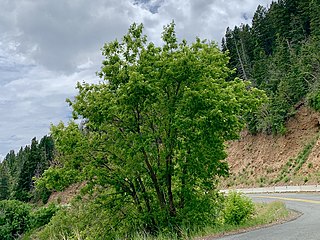
Acer negundo, also known as the box elder, boxelder maple, Manitoba maple or ash-leaved maple, is a species of maple native to North America. It is a fast-growing, short-lived tree with opposite, ash-like compound leaves. It is sometimes considered a weedy or invasive species, and has been naturalized throughout much of the world, including South America, Australia, New Zealand, South Africa, much of Europe, and parts of Asia.

The western conifer seed bug, sometimes abbreviated as WCSB, is a species of true bug (Hemiptera) in the family Coreidae. It is native to North America west of the Rocky Mountains but has in recent times expanded its range to eastern North America, to include Ontario, Québec, New Brunswick, Nova Scotia, Michigan, Maine, Pennsylvania, New York, Connecticut, Massachusetts, New Hampshire, Ohio, Indiana, and Wisconsin, and has become an accidental introduced species in parts of Europe and Argentina.
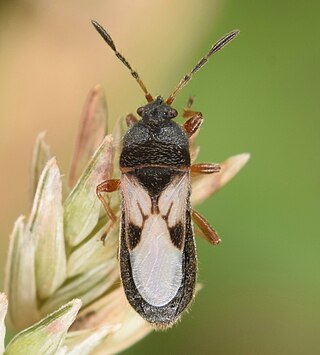
Blissus leucopterus, also known as the true chinch bug, is a small North American insect in the order Hemiptera and family Blissidae. It is the most commonly encountered species of the genus Blissus, which are all known as chinch bugs. A closely related species is B. insularis, the southern chinch bug.
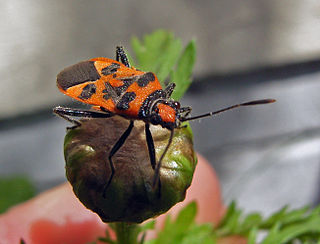
Coreoidea is a superfamily of true bugs in the infraorder Pentatomomorpha which includes leaf-footed bugs and allies. There are more than 3,300 described species in Coreoidea.

Jadera is a genus of true bugs in the soapberry bug subfamily. Members of this genus are only found in the Americas.
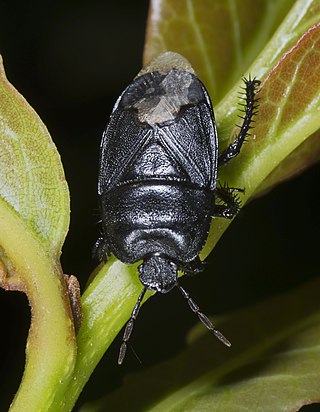
Cydnidae are a family of pentatomoid bugs, known by common names including burrowing bugs or burrower bugs. As the common name would suggest, many members of the group live a subterranean lifestyle, burrowing into soil using their head and forelegs, only emerging to mate and then laying their eggs in soil. Other members of the group are not burrowers, and live above the soil layer, often in close association with plants. Several species are known as agricultural pests.
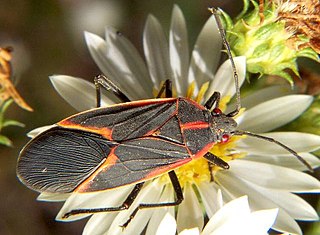
Serinethinae is a subfamily of the hemipteran family Rhopalidae, sometimes known as soapberry bugs. They are brightly colored seed-eaters, comprising three genera and about sixty-five species. These bugs are specialists on plants in the soapberry family (Sapindaceae), which includes maples, balloon vines, and soapberry trees, among others. Seeds of the plants are the main resource used by adults for reproduction and nymphs for growth and development. Their diversity is the result of an adaptive radiation on these plants, who have co-evolved defenses such as having their seeds contain cyanide, fly out, or be contained in hollow chambers.

Jadera haematoloma, the red-shouldered bug, goldenrain-tree bug or soapberry bug is a species of true bug that lives throughout the United States and south to northern South America. It feeds on seeds within the soapberry plant family, Sapindaceae, and is known to rapidly adapt to feeding on particular hosts. The species is often confused with boxelder bugs and lovebugs.
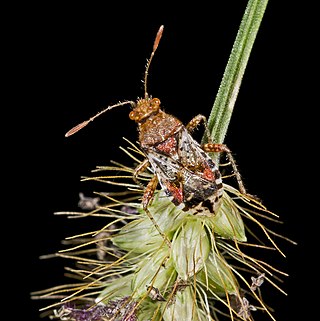
Rhopalidae, or scentless plant bugs, are a family of true bugs. In older literature, the family is sometimes called "Corizidae". They differ from the related coreids in lacking well-developed scent glands. They are usually light-colored and smaller than the coreids. Some are very similar to the orsilline lygaeids, but can be distinguished by the numerous veins in the membrane of the hemelytra. They live principally on weeds, but a few are arboreal. All are plant feeders. The type genus for the family is: Rhopalus. Currently 30 genera and over 240 species of rhopalids are known. The oldest fossil rhopalids described are from the Middle Jurassic of Inner Mongolia, discovered from the Haifanggou Formation. They are not considered economically important with a few species being pests of ornamental trees.
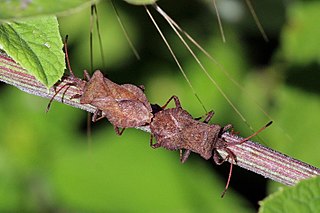
Coreus marginatus is a herbivorous species of true bug in the family Coreidae. It is commonly known as the dock bug as it feeds on the leaves and seeds of docks and sorrels. It is a medium-sized speckled brown insect, between 13 and 15 mm long as an adult, with a broad abdomen. It occurs throughout Europe, Asia and northern Africa. It is often found in dense vegetation, such as hedgerows and wasteland.

Corythucha arcuata, the oak lace bug, is a species of Tingidae that is a pest of oaks. It is native to the New World, and was first observed in Europe in 2000.

Oxycarenus lavaterae, common name lime seed bug, is a species of ground bug of the family Lygaeidae, subfamily Oxycareninae.

Corizus hyoscyami is a species of scentless plant bug belonging to the family Rhopalidae, subfamily Rhopalinae. It is commonly called the cinnamon bug or black and red squash bug.

Liorhyssus hyalinus is a species of scentless plant bugs belonging to the family Rhopalidae, subfamily Rhopalinae.

Rhopalus subrufus is a species of scentless plant bugs belonging to the family Rhopalidae, subfamily Rhopalinae. It is found in most of Europe, but not Ireland and northern Scandinavia.

Boisea is the least speciose genus of the soapberry bug subfamily. Members of this genus are found in North America, India, and Africa. Unlike other serinethine genera, the distribution of Boisea is very patchy; it is speculated that its highly vicariant range is relictual of what was previously a much vaster, continuous range. The most well-known species of this genus are the North American boxelder bugs and African Boisea fulcrata. The US species mainly feed on the seeds of maple trees and are occasional nuisance pests around homes.

Thaumastocoris peregrinus, the bronze bug, is a true bug first described from Argentina, but is probably native to Australia. The species has been recorded in Africa, Europe, Middle East (Israel), North America, South America, Caribbean, and New Zealand as a pest of eucalyptus.

Stictopleurus punctatonervosus is a species of scentless plant bugs belonging to the family Rhopalidae, subfamily Rhopalinae.

Stictopleurus crassicornis is a species of scentless plant bugs belonging to the family Rhopalidae, subfamily Rhopalinae.
Deraeocoris brevis is a species of predatory plant bug in the family Miridae. It is native to North America where it feeds on plant pests in apple and pear orchards.
























